A broad overview of the trends in Israel’s trade with China in goods and services, in the last decade
Tomer Fadlon, INSS 18.6.23
This paper surveys the trends in trade between Israel and China, in both goods and services, over the past decade (2013–2022). Especially noticeable is the significant and consistent rise in trade with Israel during those years, based mostly on the import of goods from China, which totaled $17.62 billion in 2022. The imports from China are diverse and include machinery for infrastructure and construction projects, consumer products ordered from Chinese websites, which to some degree has mitigated the rise in the cost of living in Israel, and for the past two years, the import of cars from China.
This paper also analyzes the balance of trade between Israel and China compared to the two other economic blocs with which Israel has extensive trade relations – the United States and the European Union. Despite the increase in traded goods with China, the volume of trade remains relatively smaller in comparison to that of the European Union ($49.19 billion) and the United States ($22.04 billion). Similarly, while Israel’s trade in business services with the European Union and the United States is a key component in their trade relations, it is almost non-existent with China.
Trade relations between Israel and China have been consistently and continuously trending upward, especially when it comes to goods. Between 2018 and 2020, the volume of trade with China (not including trade with Hong Kong or in diamonds) was stable, while in 2021–2022 the trade in goods – and, in fact, the import thereof – climbed significantly. According to the Israel Central Bureau of Statistics (CBS), the volume of trade in goods in 2021 increased by 27% compared to 2020, and in 2022, it further rose by 17% compared to 2021. In total, the volume of goods traded increased by almost 50% in 2022 compared to 2020 – $17.62 billion compared to $11.83 billion. Of this, imports from China rose from $6.75 billion to $13.12 billion. This is a significant increase of around 71%, while imports grew from $4.18 billion to $4.5 billion – an increase of just 7.5%. Figure 1 below shows that Israel exported goods valued at $4.5 billion to China in 2022, while it imported goods worth $13.12 billion. Similarly, China is one of the only countries in the world with which Israel’s volume of trade increased in 2020, when the COVID-19 pandemic began. In 2020, trade with China increased by 5% compared to 2019. It should be noted that Israel deviates only slightly from the global trend during those years, since Chinese exports to the world rose by 38% in 2022 compared to 2020.
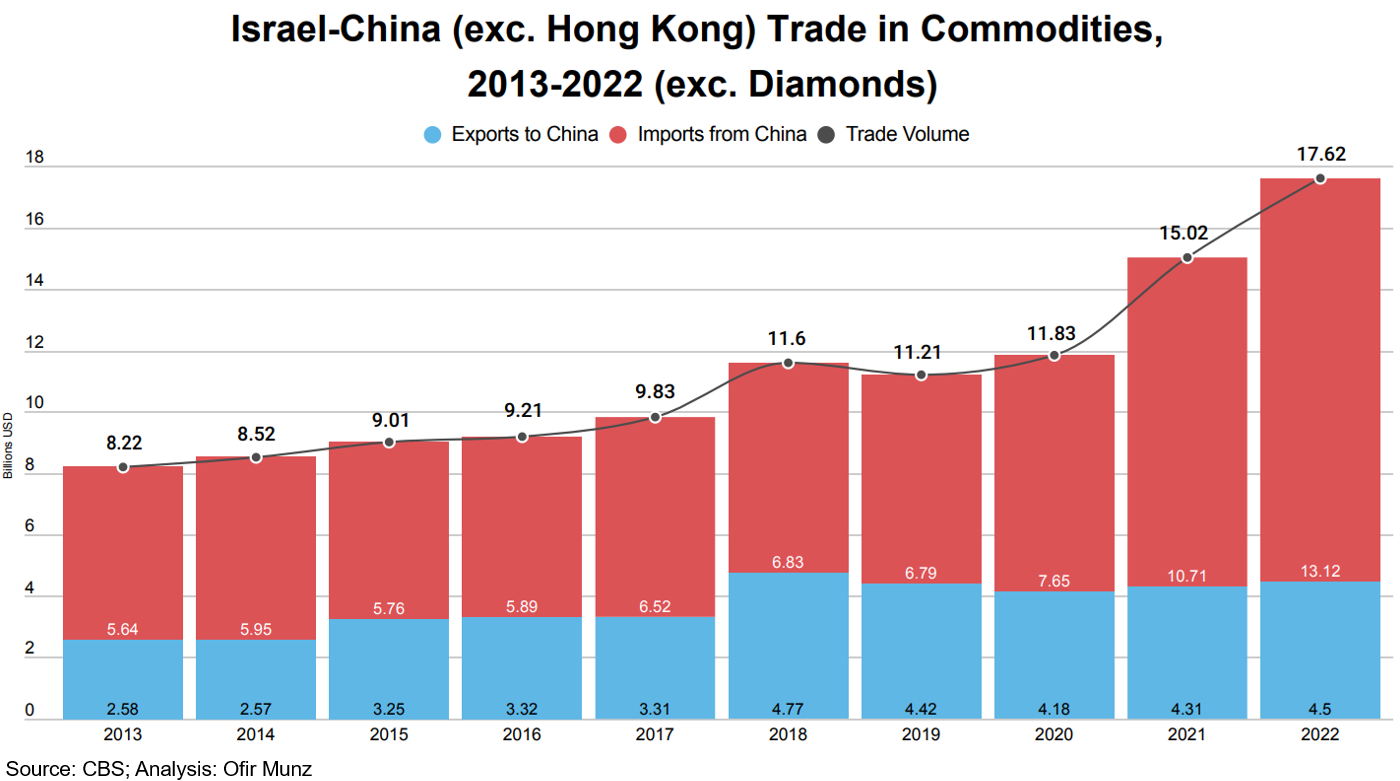
The dramatic increase in the volume of trade in the past two years was due mainly to imports of goods from China. From 2019 to 2022, annual trade with China increased by $6.41 billion (an increase of 57%), from $11.21 billion in trade in 2019 to $17.62 billion in 2022. Of that, $6.33 billion reflects an increase in imports from China, having increased from $6.79 billion in 2019 to $13.12 billion in 2022, while only $0.08 billion of this is from an increase in exports to China, which climbed from $4.42 billion in 2019 to $4.5 billion in 2022. In other words, analyzing the dramatic increase in trade between the two countries shows that imports from China are responsible for 98.8% of the increase, while the contribution of exports to China to this increase is marginal, standing at just 1.2%. It should be noted that the minimal increase in exports does not characterize the overall trend in Israeli exports. According to Israel’s Ministry of Economy and Industry, in 2022 alone there was a 15.5% increase in exporting Israeli goods abroad compared to 2021. The notable surge in imports from China can be attributed to various factors, including:
-
- An increase in online purchases from China, primarily from two websites: “Ali Express,” which for several years has been one of the most-visited websites among Israelis and during the period surveyed was the most popular website for Israelis to purchase merchandise from overseas and, in certain months, was even more popular than Israeli online shopping sites; and the online fashion store “Shein,” where Israelis spent the most money ($250 million) among the foreign-based shopping sites in 2022, and second only to the Israeli supermarket chain “Shufersal” among all the online shopping services. Notwithstanding its relatively small population, Israel is among the leading countries in the world in terms of visiting and purchasing from these two Chinese websites, which are seen as an effective method of countering the rising cost of living. For most purchases, Israelis take advantage of the exemption from Value Added Tax by ensuring that each purchase comes to less than $75.
-
- The entry of many brands of Chinese-made vehicles to the Israel market between 2021 and 2023, as detailed below.
-
- An increase in the purchase of electronic products and other goods for remote work. Despite the increase in online purchases, the majority of imports from China do not follow a direct path from the Chinese seller to the Israeli consumer but rather through stores operated by official importers. The goods available at “Max Stock,” a chain of Israeli department stores, for example, are first purchased by the Israeli importer and then sold in stores across Israel.
Meanwhile, Israeli exports to China reached an all-time high in 2018, with exports of goods totaling $4.77 billion. During that year, exports increased by 44% compared to the previous year, when the total was $3.31 billion, thanks to a growth in the exporting of electronic components, including microchips manufactured by Intel in Israel. In fact, the $1.2 billion increase in the export of electronic components in 2018 compared to 2017 – $2.6 billion of electronic component exports in 2018 compared to $1.4 billion in 2017 – constituted most of the $1.46 billion increase that year in Israel’s total exports to China. CBS figures for 2021 show that Israeli exports to China fell into two main categories: computers, electronic and optic equipment; and minerals and mining materials, chemicals, and metals (see Figure 2). According to the Israeli Ministry of Economy and Industry, the export of medical and optical equipment to China increased by 37% in 2021, as a result of both the COVID-19 pandemic, which began the previous year, and China’s 14th five-year plan, which was published early in 2021 and highlighted the importance of health and innovation – partly to address the country’s aging population. In other words, the export of goods produced by Israeli companies in various medical fields increased because of China’s need to treat chronic diseases and to help its elderly population. In addition, the export of chemicals, including fertilizers, grew by 30%. Yet despite this increase, Israeli exports of goods to China are still relatively limited and suffer from a lack of diversity, relying heavily on the exports of electronic components, especially microchips manufactured by Intel.
Although Israel’s export of goods to China decreased in 2022, valued at $4.5 billion compared to the record level of $4.77 billion in 2018, China still plays a relatively important role in Israel’s exporting of goods. In 2020, exports to China exceeded the value of exports to the United Kingdom ($3.6 billion), thereby becoming the second most important export destination for Israeli goods after the United States (excluding the European Union bloc of countries). However, when one takes the economic blocs into account, the export totaling of $4.18 billion puts China in third place, behind the exports to the European Union and the United States in 2020, which stood at $14.6 billion and $10.4 billion, respectively. Similarly, it should be remembered that Israeli companies could face difficulties exporting microchips and other advanced technological equipment because of the tension between the superpowers and American restrictions in sensitive areas. The export of electronic components makes up more than half of all of Israel’s exports to China and the concern is that Israel’s relative advantage in exporting technology could limit exports to China and lead to the non-realization of the export potential.
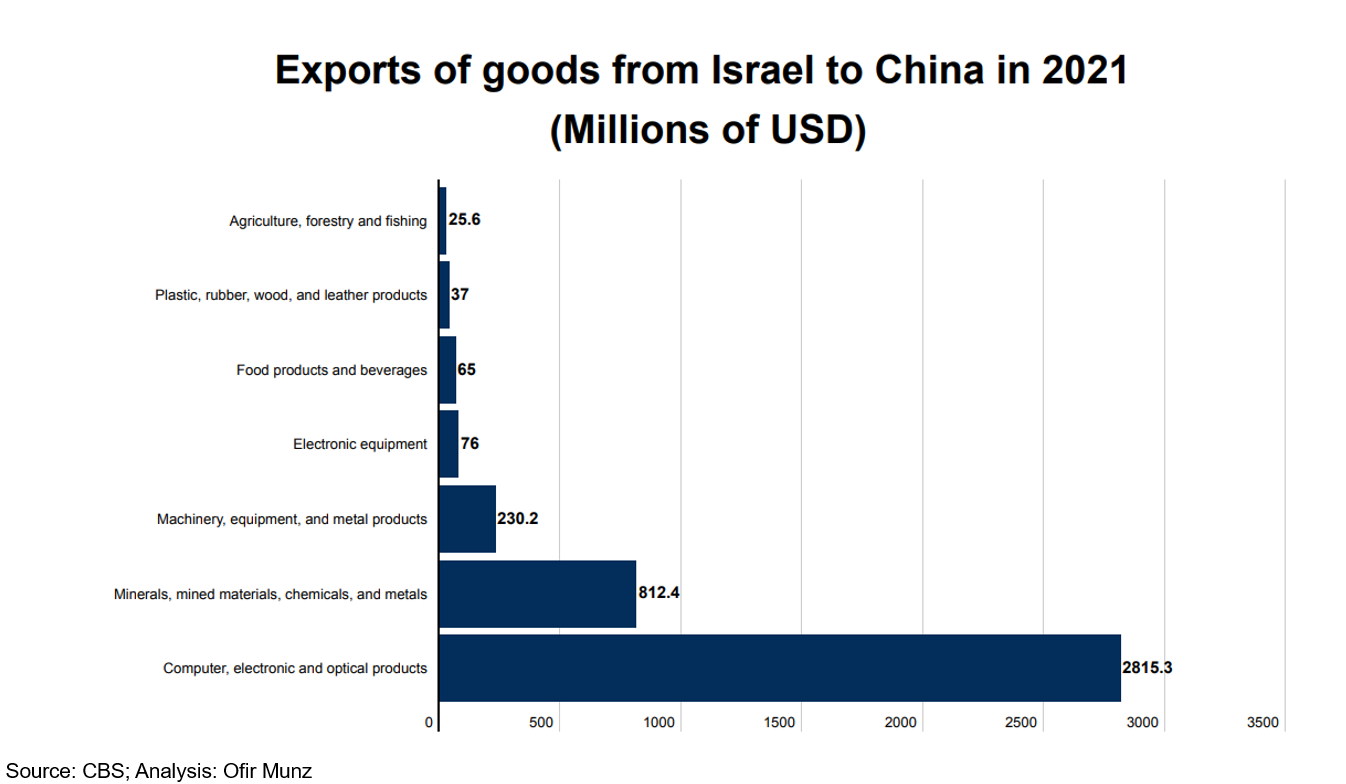
The dramatic rise in the import of goods from China, alongside the stagnation in the export of goods, has increased Israel’s trade deficit year after year, setting a new record in 2022. Last year, the trade deficit stood at $8.62 billion, compared to $6.4 billion in 2021. In fact, Israel’s trade deficit with China has increased by around 360% since 2019, from $2.37 billion in 2019 to $8.62 billion in 2022 – a faster rate of increase than with any other country (see Figure 3). The CBS review shows that Israel’s trade deficit with China is the highest of all the countries that it trades with – far ahead of second-placed Switzerland with which Israel had a trade deficit of $5.5 billion in 2022. On the other side, Israel’s greatest trade surplus in 2022 was with the United States ($4.6 billion). The significant increase in imports of goods from China in recent years, at a time when exports plateaued, has led to an ongoing increase in Israel’s trade deficit with China. Indeed, each of the past three years has seen the deficit reach record levels. In 2020, the deficit stood at $3.47 billion, compared to the previous record of $3.21 billion, which was set in 2017. In 2021, the deficit rose significantly to $6.4 billion and in 2022, as mentioned, it crossed the $8 billion threshold. Israel is far from unique when it comes to having a trade deficit with China, since this is the case for most countries. When China became the “world’s factory,” it also turned into a country that enjoys a consistent trade surplus. As of 2021, China was the country with the highest trade surplus in the world – $675 billion – considerably ahead of Germany in second place, which has a trade surplus of $211 billion.
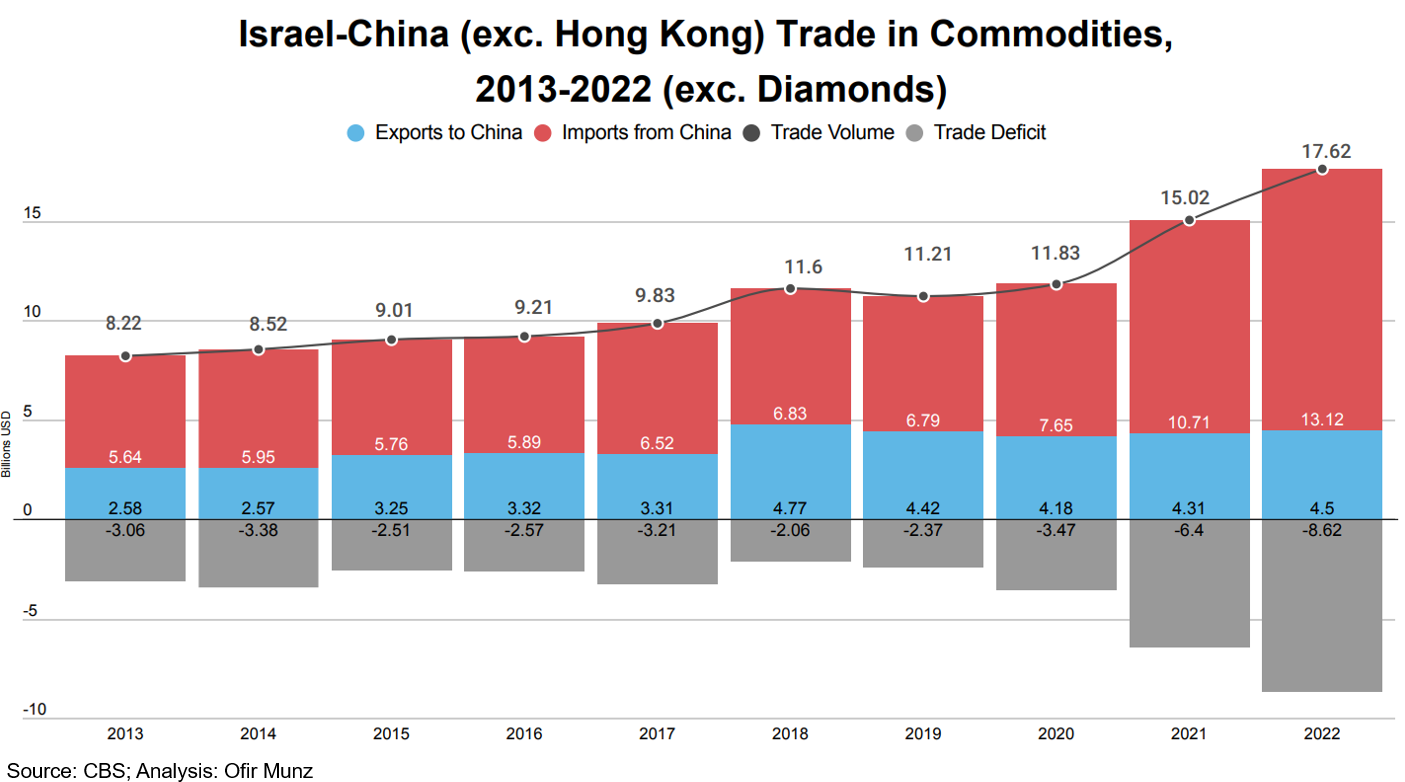
Trade in Goods: A Comparative Analysis
Over the past decade (2013–2022), Israel’s trade in goods has steadily increased (see Figure 4). In 2013, for example, Israel’s global trade in goods stood at $120 billion; by 2022 this trade had risen to around $162 billion – an increase of 35%. Over the same period, the volume of trade in goods between Israel and China increased by around 115%, from $8.22 billion in 2013 to $17.62 billion in 2022. China alone accounts for approximately one-quarter of the growth in goods trade between Israel and the rest of the world.
Trade with the United States increased during the same period by 26%, from $17.43 billion to $22.04 billion, while trade with the European Union rose by 34%, from $36.7 billion to $49.19 billion. It is important to note that, during those years, the calculation method for trade with the European Union underwent changes by the CBS, and since 2021, trade with the United Kingdom has been calculated separately because of Brexit. Similarly, the proportion of trade with China increased during those years from 6.8% ($8.22 billion) of Israel’s total global volume of trade in goods in 2013 to 11% ($17.62 billion) in 2022. Even after this increase, China is still the third largest trade partner, following the European Union at 31% of Israel’s total global trade in goods, and the US at 13.5%.
It should be noted that the volume of trade with China is greater than any individual trading partner from the European Union. When analyzing the imports of goods, the European Union takes the lead followed by China in second place. However, upon closer examination of individual countries, the import of goods from China surpasses any other country significantly, amounting to $13.1 billion in 2022. In comparison, imports from the United States accounted for $8.7 billion, and imports from Germany amounted to $7.1 billion.
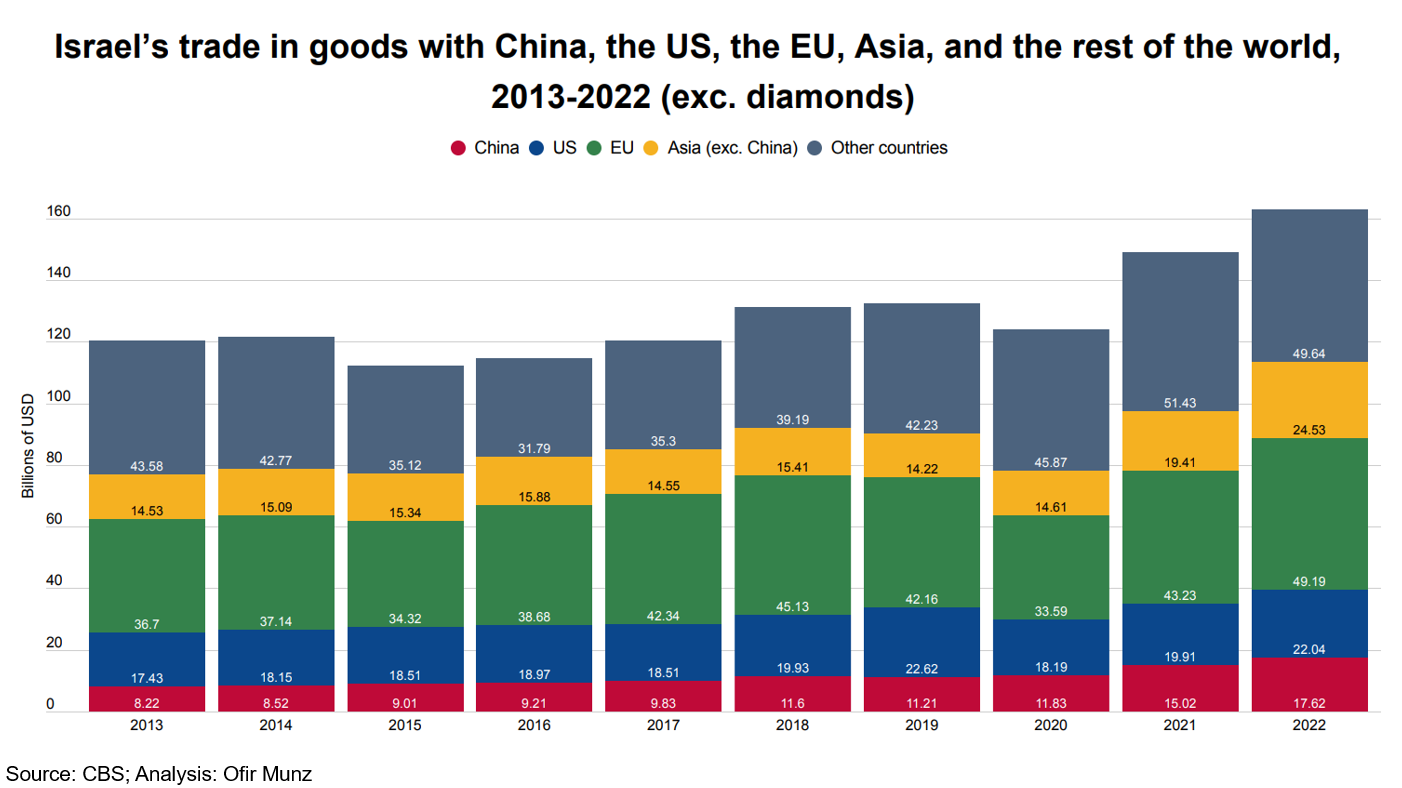
Several conclusions can be drawn from a broad analysis of Israel’s trade in goods with China compared to the other large economic blocs in recent years. First of all, trade with China has grown consistently and even rose in 2020 compared to the previous year. Due to the influence of the COVID-19 pandemic, trade with the other two blocs dropped significantly in 2020. Secondly, trade with the United States has still not returned to its pre-pandemic levels, while trade with China has grown by almost 50% since then. Thirdly, despite the concerns that an economic slowdown would harm trade with the European Union and of a possible boycott of Israeli goods, trade has increased with the European Union. While the COVID-19 pandemic exacerbated these concerns, trade increased by 16% in 2022 compared to 2019. Fourthly, trade with Asia continues to trend upward even without China, having increased by 72% compared to 2019. This is a good representation of Israel’s eastward expansion and the variety of trade relations it enjoys.
The figures presented here are based on the way the CBS and the World Trade Organization categorize China in the global trade system. That is, China and Hong Kong are seen as two separate entities when it comes to global trade. From a geopolitical perspective, there is some logic in analyzing trade with Hong Kong as part of the trade with China, given that China controls Hong Kong and can influence Hong Kong’s economy for political considerations and can use the territory to advance its own strategic interests. However, even if we were to examine the data of the two economic entities as one unit, it would not significantly change the overall picture. In this case, trade with China, including Hong Kong, would still be the third largest, after the European Union and the United States, with a combined volume of trade in goods of $21.08 billion in 2022 (see Figure 5). The only aspect that would vary is the proportion and significance of trade with China, including Hong Kong, since the proportion would rise from around 11% to 13% of Israel’s total global trade. Similarly, according to the trend of increased imports from China in recent years, it is feasible that trade in goods with China, including Hong Kong, could surpass trade in goods with the United States by 2023.
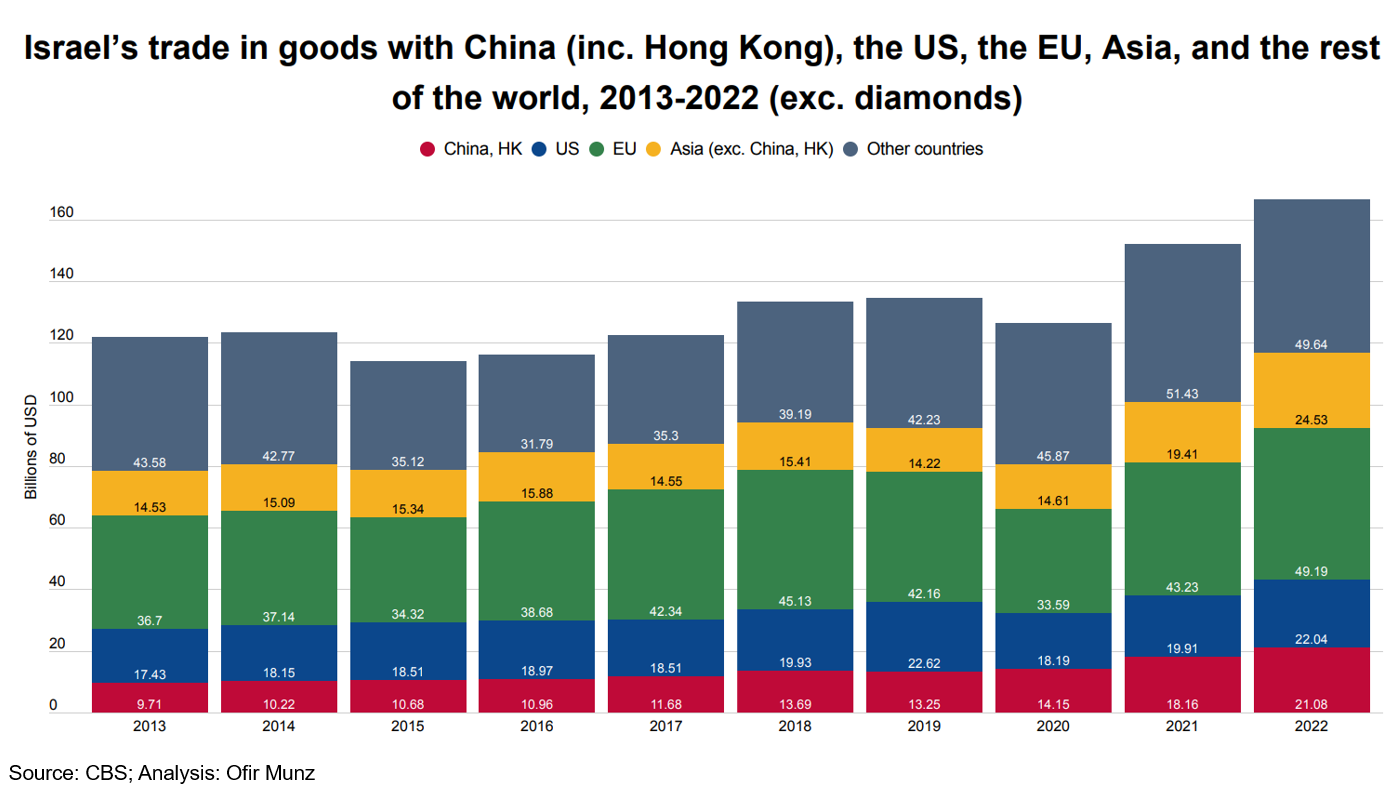
Car Imports from China
The arrival of Chinese vehicles on Israeli roads is one of the most interesting phenomena in terms of Sino–Israeli trade relations. Up until 2022, the most common Chinese car on the Israeli roads was the British MG brand, which the Chinese company SAIC Motor purchased in 2005 and manufactures in China.[1] Geely overtook the sales of Tesla and ended 2022 as the best-selling brand of electric vehicle in Israel. With close to 7,000 deliveries in 2022, Geely sales increased by 4,000% compared to 2021 (see Figure 6). In fact, the list of the 10 best-selling electric vehicles in Israel contains six Chinese manufacturers. Therefore, it is not surprising that more than half of the electric vehicles sold in Israel in 2022 (14,300 out of 27,600 vehicles) were Chinese brands. Sales of some brands could have been even higher were it not for supply-chain issues, which slightly reduced the number of vehicles imported.
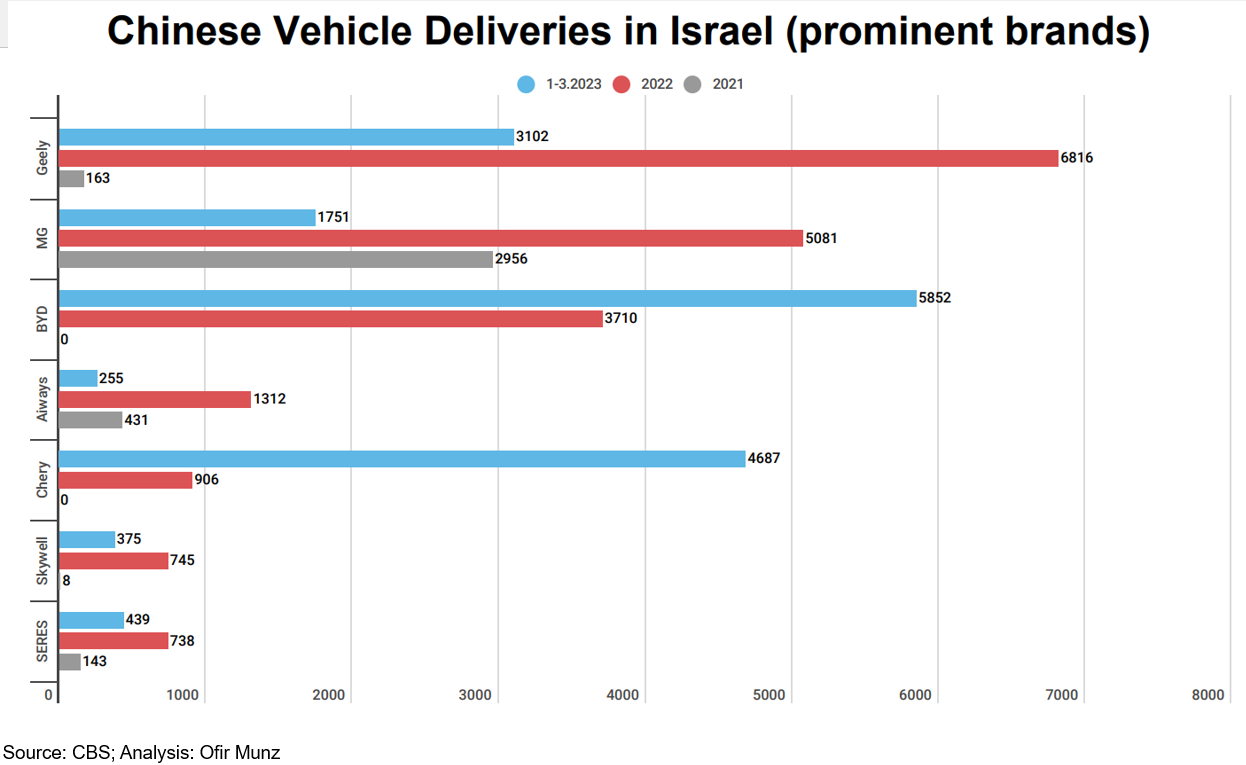 <
<
>
It is evident that this trend continued through the first quarter of 2023, when the import of cars from China set new records. Between January and March, around 105,000 vehicles were delivered in Israel – and more than 12,000 of them were Chinese brands.[2] The new brand – Chery – delivered 4,687 vehicles. At the current rate, the number of Chinese vehicles delivered by the end of 2023 is expected to double from the previous year. According to Chinese tariff figures, in January and February of 2023, Israel became the third largest destination for Chinese car exports, after Russia and Mexico. It is possible that the dramatic increase stems, inter alia, from the wish of the consumers to avoid the rise in purchase tax on electric cars: in January 2023, purchase tax rose from 10% to 20%, and it is likely to reach 35% in January 2024.[3]
The increase in the exports of Chinese vehicles is not a phenomenon that is unique to Israel. In 2022, China exported more than 2.5 million passenger vehicles, an increase of 56% compared to the previous year. Chinese vehicles have gained in popularity across the world mainly because of price considerations. Electric vehicles are more expensive than diesel or gasoline-powered vehicles and Chinese electric vehicles are not only cheaper than competing electric vehicles, but also cost less than some non-electric vehicles. In fact, Chinese vehicle exports have surpassed most major car-manufacturing giants – including Germany – making China the second largest exporter of cars after Japan. However, the export and delivery of vehicles around the world only tells part of the story, since international trade is usually measured according to value, not quantity. As a result, in 2021, the last year for which we have data about the value of vehicle exports, China was in fourth place globally in terms of quantity, but in 12th place in terms of the value of those exports. In other words, China is taking over the global car market – even if not in terms of value.
Trade in Business Services
Despite the impressive growth in Israel’s volume of trade with China, most of the increase is from trade in goods, while trade in business services, which represents the main catalyst in Israel’s international trade, remains far behind. According to data from the World Trade Organization for 2021, 40% of Israel’s international trade is in business services. Moreover, the export of business services is the most important element of Israel’s international trade and has been on a constant upward trend in recent years, thanks to high demand for Israeli computer and information technology services, as well as Israeli research and development, which gained an international reputation even before the COVID-19 pandemic. The pandemic gave these industries a significant boost, expanding demand for computer services from Israeli companies. In 2021, Israel exported business services with a value of $60.7 billion, a significant increase of 50% compared to 2018 ($40.4 billion). The import of business services also grew significantly during that period, but not to the same extent: from $15.5 billion in 2019 to $20.3 billion in 2021 (an increase of 30%).
Trade in business services is most developed with the United States and the EU, which accounts for more than half of Israel’s trade in business services. According to CBS figures, around one third of the total of Israel’s trade in business services for 2021 was with the United States (trade valued at $25.98 billion out of a total of $81 billion), while 10.7% ($8.74 billion) was with the European Union (see Figure 7). Trade in business services between Israel and China is almost nonexistent.
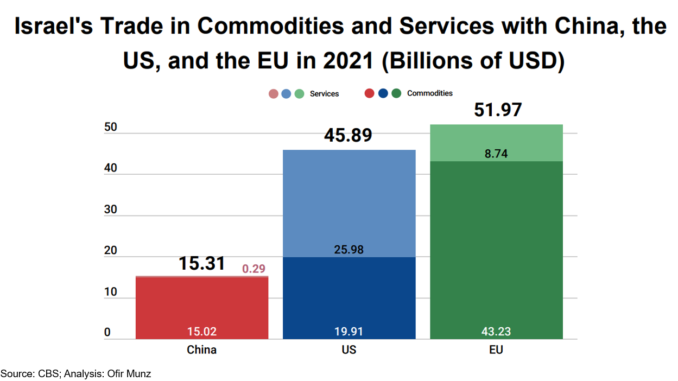
In 2021, Israel exported $154 million worth of business services to China and imported business services valued at $143 million (see Figure 8). Hence, the export of business services to China constituted 0.25% of Israel’s total exports of business services in 2021, while imports of business services from China amounted to 0.75% of all business services imports. Apart from these low figures, in 2021 the upward trend in trade in business services between the two countries came to an end, and both the import and export of business services have decreased. The export of business services dropped by around 10%, while the import of business services dropped even more sharply. After setting a new import record for business services in 2022 – $255 million – Israel’s import shrank by more than 50% to $143 million in 2021.
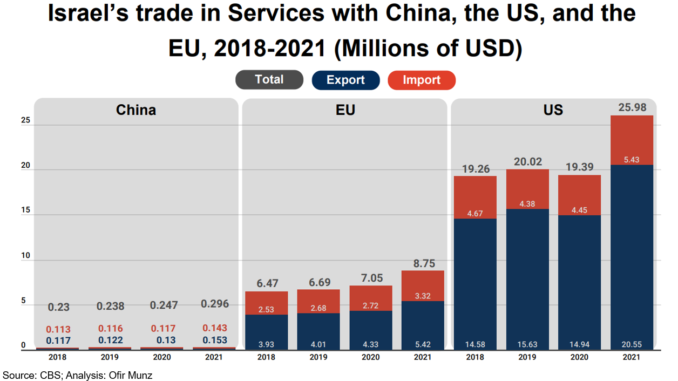
<
>
By analyzing the segmentation of the export of business services to China in 2021, it is apparent that around one-third of the total exports are computer and information technology services ($49.5 million) (see Figure 9). This figure is in line with the general trend since these services also make up around 40% of the total export of business services from Israel. However, when it comes to the types of services, it is evident that China does not follow the prevalent trend. Intellectual property royalties make up more than one quarter of Israel’s exports to China ($39.67 million), while they make up just 1.3% ($748 million) of the total value of business services exports from Israel in 2021. The gaps are also evident when it comes to construction services, which make up more than one fifth of Israel’s business services exports to China ($32.18 million), while they make up only a tiny fraction ($638 million) of Israel’s total exports of business services. Similarly, research and development, which makes up more than 15% ($9.4 billion) of the total Israeli export of business services, constitutes around 2% of business service exports to China. The gaps in this kind of service are prominent when comparing China to the United States: $7.8 billion of R&D exports to the United States, compared to just $3 million to China.
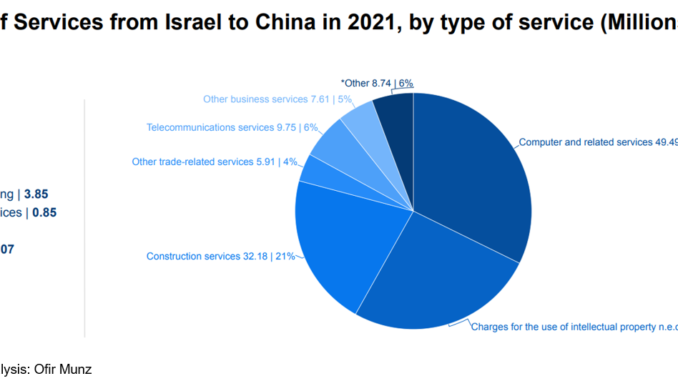
Analyzing the segmentation of business services imports reveal an interesting picture, which explains the significant differences between 2020 and 2021. In 2020, around half of Israeli imports of business services from China ($129.5 million) focused on renting equipment for several large-scale infrastructure projects in Israel, including the Tel Aviv light rail transit project. This clause remains blank in the CBS figures for 2021 and explains the sharp drop in the import of business services from China in 2021. Construction services, which account for around 3% of Israel’s total import of services in 2021, make up more than a quarter of the import of services from China for the same year ($37.57 million) (see Figure 10). Other industries, which are well developed when it comes to trade with OECD members and make up a substantial proportion of Israel’s imports of business services, are not developed at all with China. These services include financial, business, advertising, computing, and sales and marketing services.
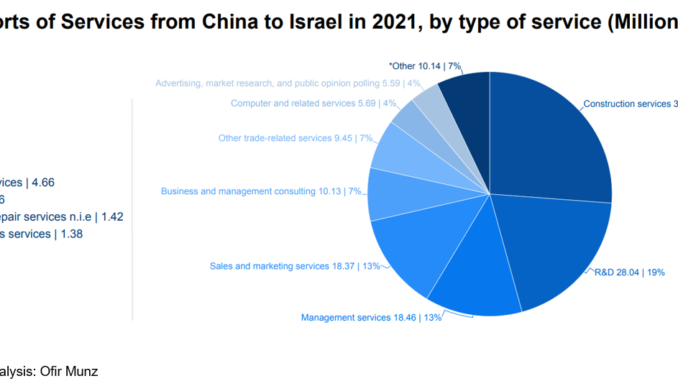
Conclusion
Analyzing the volume of trade between Israel and China paints a clear picture of a constant upward trend. During the COVID-19 pandemic, China stood out as one of the very few trade partners in the world with which trade with Israel experienced growth. However, a deeper look at the trade balance between the two countries shows a more complicated picture. Trade relations between the two countries rely heavily on the import of goods from China to Israel, which makes up around 70% of the total international trade in goods and services between the two countries. This trend continues in light of the volume of Israeli goods exported to China, which is based primarily on the activities of two main companies and has not risen significantly since 2018. These trends significantly increase the trade deficit between the two countries, which peaked in 2021 – the same year in which the import of Chinese vehicles to Israel became a significant factor. Israel must avoid a situation of being overly dependent on the import of goods from China and must continue to import from a variety of countries – especially when tensions between the superpowers have increased. Similarly, trade in business services between the two countries is almost nonexistent. Indeed, China is a superpower in terms of international trade in goods, but not in services, which make up just 10% of its total international trade. In Israel’s case, however, trade in business services has shrunk to less than 1% annually and is not a significant factor in bilateral trade. In fact, there is a significant gap between Israel’s export potential, which in recent years has become a major exporter of these services, and the realization of the negligible potential in terms of trade in business services with China.
These two phenomena are entirely different from Israel’s trade with the United States and the European Union. With these two countries, there is significant trade in business services, which largely explains the growth in the volume of trade. For example, while trade in goods with the United States has not yet reached its pre-COVID-19 level, trade in business services significantly trends upward every year. Therefore, despite the growing importance of China as Israel’s trading partner, the volume of trade with the United States and the European Union and the diversity in the ratio between imports and exports and between goods and services explain why China is still the third most important trading partner for Israel, with trade in goods totaling $17.62 billion in 2022, and constituting about 11% of Israel’s total trade in goods in 2022. This, of course, is contrary to the global trend, according to which China is the largest trading partner of more than a hundred countries in the world.
Similarly, increasing imports from China raises questions about the future of the free-trade agreement between Israel and China, an issue that has been on the agenda since 2016. The consistent growth in imports from China adds funds to the treasury, thanks to the various tariffs, including on batteries and vehicles. A free-trade agreement would significantly reduce the state revenues from these tariffs, and, during periods of economic uncertainty, it is hard to envisage that the Israeli Finance Ministry would rush to give up the large revenues resulting from the increasing imports from China.
Beyond this, the discussion of trade with China would be incomplete without acknowledging the great power competition and its possible ramifications on international trade. The increased tensions between Washington and Beijing since the start of the trade war have affected Israeli exports to China. The concern of Israeli companies that their activities vis-à-vis the United States could be threatened could make Israeli exports to China even more difficult and could lead to a drop in overall exports to China as the conflict between the superpowers intensifies. Therefore, Israel is forced to conduct its trade relations with China out of economic and commercial interests, while taking into consideration US demands and taking advantage of opportunities along the way. Israel’s relative advantage in technological fields, especially the export of hi-tech services, is currently limited in terms of development potential vis-à-vis China and may become even more restricted in the future. In contrast, some of the life science and medical fields, currently of interest to the Chinese, have the potential to expand their exports from Israel, without creating any superfluous tensions with Washington. China’s emphasis on health and its aging population creates a golden opportunity for the export of Israeli pharmaceutical companies and medical equipment to China, without getting involved in the great power competition. In recent years, China’s population over the age of 60 has climbed steadily, from around 13% in 2010 to 18% today and is projected to reach 26.2% by 2030. Israel, therefore, should focus, inter alia, on exporting goods and services in those fields, to increase the volume of trade with the world’s second largest economic power.
_________
* The author would like to thank Ofir Munz for his help writing this article and for converting the data into graphs.
[1] A total of 268,000 vehicles of all kinds were purchased in 2022. The purchase of electric cars made up just 6%, but there is a sharp upward trend. The market share of Chinese brands among all electric vehicles sold that year in Israel exceeded 50%.
[2] Although this article focuses on Chinese brands, some non-Chinese vehicles are manufactured in China, including Tesla, some of which are manufactured in Shanghai.
[3] For comparison, purchase tax in Israel on non-electric vehicles is 83%.
The opinions expressed in INSS publications are the authors’ alone.<
Dr. Tomer Fadlon is a Research Fellow in the Economics and National Security Program and the Israel-China policy center – The Diane and Guilford Glazer Foundation at the Institute for National Security Studies. Fadlon’s publications address a wide range of issues related to the global and regional economy, and how these economic and political developments affect Israel. Fadlon also completed his PhD at the School of Political Science, Government, and International Relations at Tel Aviv University. In recent years, Fadlon is a lecturer of several courses at Tel Aviv University mainly such as “Political Economy,” “The International System.”<



Leave a Reply
You must be logged in to post a comment.